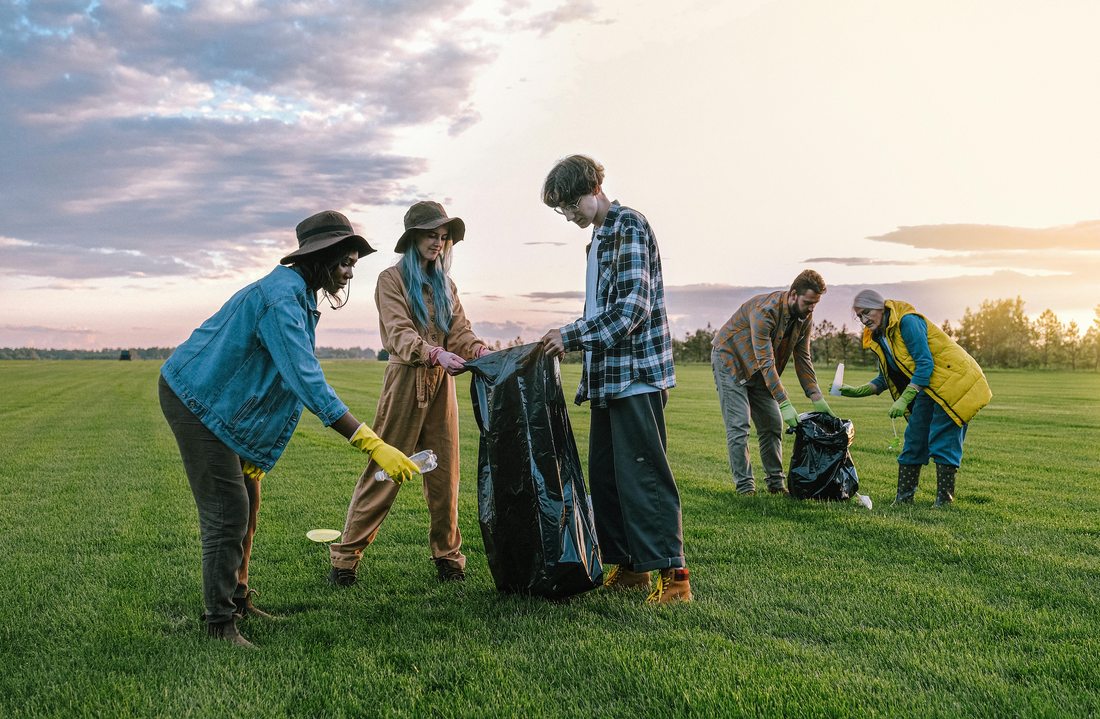Engaging in community activities is a powerful approach to creating identity, pride, and responsibility within your community. If you are not an experienced event planner or are planning a trash pick-up day for the first time in your community, this article will cover all the necessary steps to host a successful community trash clean-up day.

(2023 photo of me at the Yosemite FaceLift®, an annual clean-up day hosted by the Yosemite Climbing Association. I ended up scooping about 14.6 pounds of trash!)
Understanding the Importance of a Community Trash Clean-Up Day
Before diving into the work required to set up your event, it is important to understand why it is so beneficial to the community. These ideas will help you build out the event, and may convince more people to assist in your cleanup efforts!
-
Environmental Impact: Besides being an eyesore, trash is harmful to your local ecosystems. It can hurt wildlife and pollute water sources. During a litter pick-up day, your community takes one step toward a cleaner, healthier neighborhood.
- Pride in Community: Clean streets, parks, and other public spaces encourage residents to feel proud of their community and, in turn, motivate them to treat their neighborhood with respect. Think about where you grew up. Do you have pride in that neighborhood?
- Strengthening Social Ties: These events provide opportunities for neighbors to meet and work together. As they form new relationships, the community becomes a stronger, more supportive place to live.
- Educational Value: When participants learn how easy it is to alter their daily routines, like picking up trash while on a walk, that knowledge will stick with them.
Litter pick-up days are a great way to unite people in cleaning up your neighborhood while building relationships, creating a sense of community service, and improving your environment.

Planning Your Trash Pick-Up Day
Proper planning is the key to a successful day. Here are some tips to ensure your community trash pick-up day goes off without a hitch.
Assemble a Planning Team
There is no great event without a team behind it. Even a team of two people will work! If you have more than two, that is great, and it is key to distribute roles like outreach, logistics, and supplies, according to individual strengths. A team provides the infrastructure to cover all the event needs while keeping everyone’s workload in check. Can you do this alone? Absolutely. But, having a partner assist and take half of the planning into their hands can be helpful. Plus, you already have a two-person event, so you are doubling your impact!
Choose a Date and Time
How can you select a date to maximize participation? Weekends typically work the best because they correspond with people’s availability. The summer may work best if you want school-age participants. Think about how successful you might be if you recruited some local high school students to volunteer!
If in doubt about the timing, contact your local city hall to find out if there are any particular holidays or commemorations that might boost attendance. You may also search around to see if there are any local events already planned that can help your efforts. I find it helpful to look around on Google and Facebook for “conservation events near me” to see if other events are already planned.
For example, Earth Day every April may be a good time to plan an event. If you want your event to fall during a certain time of year, you could organize a “Spring cleaning” or a Fall “Crisp & Clean // Leaf it Clean” campaign. Your event will be even stronger if linked to other environmental activities in the same week or month, and a catchy name always helps!
Identify the Areas to Clean
With your planning team, think of the area that needs to be cleaned. Examples might include a park, a stretch of road, a playground, a beach, or a local trail – in short, any public space near you. Your local government or environmental groups might have suggestions for areas that need attention.
Obtain Necessary Permits
Contact your local municipality to find out if your event requires permits, especially if you are cleaning up public spaces or large areas. One key benefit to asking the local municipality is that they might even provide supplies, such as gloves and bags, or they may offer to clear away garbage bags if you leave them in a designated location. Some counties issue permits for gatherings, while others require a permit to collect a large amount of trash or to use public lands in certain ways. Getting any permits upfront demonstrates that your event is organized and accountable.
Plan for Waste Disposal
An important aspect of ensuring your event runs smoothly is managing waste collection, and disposal.
Contact your local waste management services ahead of time so that you can work out a plan for trash collection and pick-up of your collected debris. Again, your local municipality may help you with this, so reach out to see if they have any options.
Make plans for recycling when possible and be sure to instruct your volunteers how to separate recyclables from general waste based on the general rules in your town.

Gathering Supplies and Resources
It is crucial to ensure you have all the necessary supplies for a community trash pick-up day. Take a look at the below list of items you will need:
-
Trash Bags and Bins
- For any large-scale trash collection event, it is useful to have heavy-duty trash bags. Color-coding these bags can help make sorting easy and avoid contamination of recyclables. For instance, blue or white trash bags can be used for recyclables, and black heavy-duty bags for general waste, but this depends on your town’s rules. Make sure you know where you will dispose of the full trash bags. Some event planners take the bags home with them or spread them out amongst the volunteers to place in their weekly trash bins. Some towns may have public dumpsters to use.
-
Gloves and Safety Gear
- It is important to provide gloves for volunteers to be protected against broken glass or cuts from sharp objects. If you do not have enough gloves, ask participants to bring their own pair, but make sure they are sturdy gloves! If you are working beside a street, in areas with traffic, or even in the woods during hunting season, it is appropriate to wear bright-colored clothing. This is potentially another area where your local municipality can help. My town, for example, provides bright orange safety vests and even will put up road signs that say “Litter Pickup Ahead” to warn drivers. Other safety items your event will need are first aid kits, sanitizers, and sunscreen – these will guarantee that your event runs smoothly and everyone has a great time.
-
Tools
- When larger items are to be collected, you might need rakes, brooms, and shovels for clearing debris. Grabbers or tongs can be used when picking up small items to help prevent back strain from continually bending over. If you find large items like tires, some municipalities also offer to clear these for you if you leave them in a pre-determined location.
-
Refreshments
- Water, snacks, and possibly even providing lunch will go a long way toward keeping your event pleasant and fun. Having refreshed, cheerful volunteers at the end of the day helps to ensure your event wrap-up is positive. You can even ask local businesses or restaurants to sponsor refreshments in exchange for publicity or partner with a local grocery store to provide refreshments at reduced prices. Offering refreshments to your volunteers keeps them happy and incentivizes them to stick around longer.

Promoting Your Trash Pick-up Event
Publicize your event! Especially if you would like the event to be larger, take advantage of the below strategies to announce your community clean-up day.
Social Media
Do you want a larger event with 10+ people? A solid social media strategy might help! Creating event pages on Facebook, Instagram, and Twitter, posting information about the event regularly, and asking people to RSVP are all helpful to increase awareness. You can even encourage others to share the event with their networks to help generate buzz.
Flyers and Posters
Create flyers and posters and put them up in high-traffic areas, including community centers, schools, libraries, and local businesses. You can google “Trash pick-up day template” to find flyers you can easily customize for your event. Make sure the date, time, location, and contact information are clear and easy to read. Adding a QR code to your flyer will maximize those RSVP responses, and are often found in template applications. Also, local businesses might be willing to post your flyers in their shop windows. After the event, make sure you collect and recycle the flyers!
Partner with Local Organizations
Partner with local schools, businesses, nonprofits, and community organizations to get them involved in your event. This can be super low-key if you want it to. For example, you might ask the local high school to inform students about the upcoming event and encourage them to volunteer. Additionally, these partnerships can also result in sponsorships that offer additional money or needed supplies so the event can get even better.
Day-of-Event Management
Here are some suggestions to keep everything running smoothly during the event:
- Set Up a Check-In Station Have a central place where volunteers check in, pick up supplies, and get orientation. Make sure everyone knows where to check in and at what time. You should be there at this time to let volunteers know where to go, give them instructions for the day, and answer any questions.
- Brief Your Volunteers. Take a moment at the start of the event to call a meeting to explain what tasks are ahead, the safety measures in place, and any specifics about the area being cleaned. If multiple people show up, dividing your teams into zones for the cleanup efforts can be most effective. If the area is large or contains potentially dangerous elements, remind volunteers to look out for each other.
- Capture the Moment If you can, make sure to take some photos, or ask a volunteer to be the photographer for the day. Even just two or three photos are a great way to set yourself up for future promotional campaigns and to thank volunteers for attending.
Final Thoughts
Planning a community trash clean-up day is a great service project, but it is more than that. It is also a wonderful way to unite the community, beautify your neighborhood, and encourage a culture of environmental stewardship. By following these steps, you can ensure that the process is as effective as possible and is fun for all participants.

